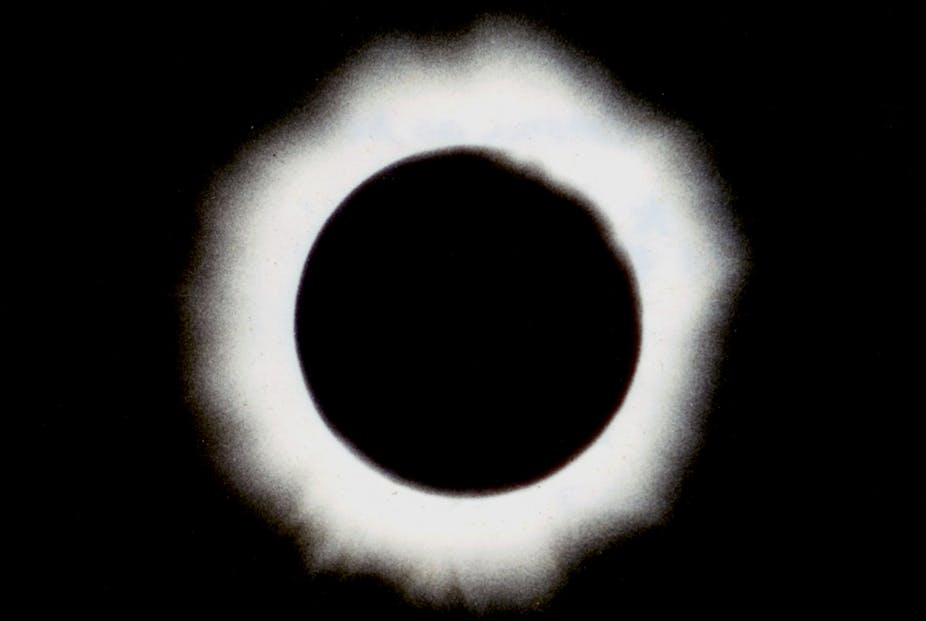Shortly after sunrise tomorrow morning the skies will go dark in northern Queensland. Many people, including myself and plenty from overseas, are flocking to Cairns to observe this celestial phenomenon – a total solar eclipse.
Just after sunrise the moon will slowly start to move in front of the sun and after an hour or so (at 6.38am in Cairns), the sun will be blocked from view for roughly two minutes. After that the moon will move beyond the far “edge” of the sun and our star will become visible once more.
At the height of the eclipse, the light will fade to twilight level even though it will be mid-morning. Indeed many animals will be confused and behave like it was sunset, and bright stars and planets will be visible in the sky.

Halos and diamond rings
One of the highlights of an eclipse, and one that I am particularly looking forward to, is the unique chance to see the upper parts of the sun’s atmosphere, called the corona (see image below).
While the sun is entirely blocked by the moon, we see the corona as a halo around the sun/moon disc. We are normally unable to see the corona because of the brightness of the sun.
Just before and just after the totality (the point at which the sun is completely covered) we will also see a phenomenon called the “diamond ring” (see image further below). This is when only one bright spot appears on the “edge” of the moon, resembling a diamond ring.

This effect tells us something very important about the moon – the surface of the moon isn’t smooth, but features mountains and craters.
The diamond ring effect appears because we watch the disc of the sun through the mountains and craters on the “edge” of the moon.
Celestial coincidence?
The diameter of the moon is approximately 400 times smaller than that of the sun. But the moon also happens to be 400 times closer to the earth than the sun.
This means the moon will only cover the entire sun when seen from a small strip on Earth.
If you don’t happen to be in northern Queensland, you can still see the eclipse, but the moon will never cover the sun entirely. What you will see is a “partial eclipse”, and you will not get the twilight experience.

If you’re in Brisbane, the moon will cover roughly 80% of the sun, if you’re in Sydney, the percentage will be closer to 70% and if you’re in Melbourne, it will be roughly 50%.
(A table of partial eclipse times – including the percentage of the sun covered at each location – can be found here.)
Once in a lifetime?
It might surprise you to learn that total solar eclipses aren’t actually rare. They happen, on average, every 18 months, but as they are only visible from a narrow band on the earth’s surface, it can be centuries between total eclipses for a given location.
The previous total eclipse visible from Australia was in 2002 (see video below). The next one will be in July 2028 and Sydney will be in the totality strip.
The next total eclipse in Cairns will be in 2077, but residents will see a solar eclipse of a lesser kind in Cairns in 2013.
This so-called “annular eclipse” will happen at a time where the moon’s orbit is slightly further from the earth. As a result the moon won’t appear big enough to cover the sun entirely, leaving an outer ring of the sun visible.
(The moon is actually spiralling slowly away from the earth, so in the far future, there will no longer be any total solar eclipses, just annular eclipses.)

Observing the eclipse
You should never look directly at the sun without proper eye protection as you can give yourself permanent eye damage.
If you don’t have any proper eclipse glasses, the easiest way to observe a partial eclipse is to stand with your back facing the sun and hold out a large piece of card with a small hole (2mm), so the sunlight can pass through the hole and project on to another piece of paper (or wall) roughly a metre away.
Even better, your local observatory or astronomy association might be hosting an event where you can watch the eclipse through proper equipment, and with enthusiastic astronomers explaining this exciting phenomenon.
If you’d like to learn more about tomorrow’s eclipse, see this factsheet produced by the Astronomical Society of Australia or this website.

